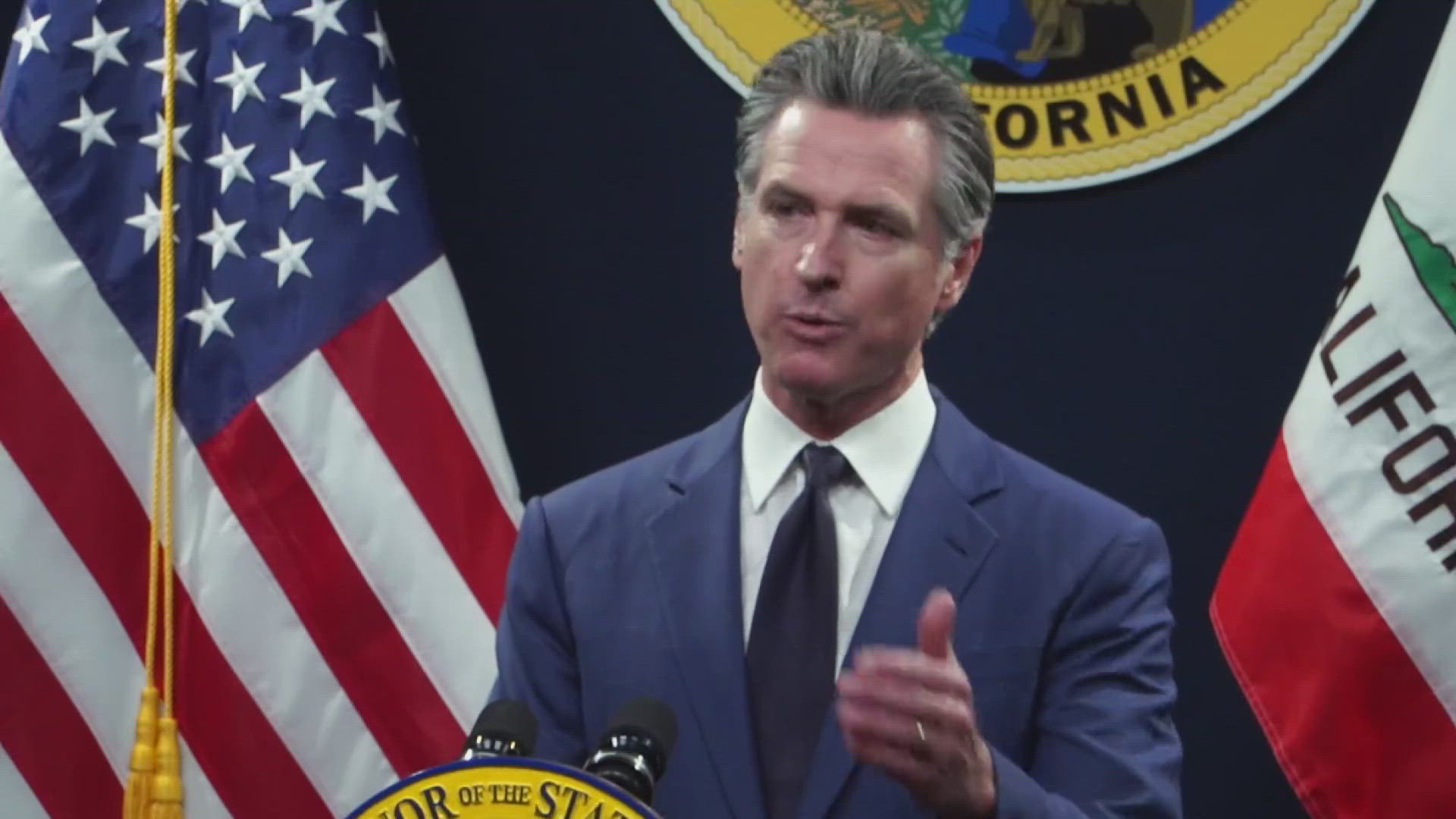SACRAMENTO, Calif. — California has a budget deficit of $27.6 billion, Gov. Gavin Newsom announced Friday — a gap so wide that he's proposing eliminating 10,000 vacant state jobs and cutting spending across 260 state programs.
The Democratic governor outlined the deficit Friday as part of his proposed $288 billion state budget for the fiscal year that starts July 1. That's by far the largest budget of any state.
One-time cuts would include $2 billion for broadband that would have expanded broadband connections, $272 million for employment services for the state’s welfare program, and $500 million for water storage in the drought-plagued state. He said those water storage cuts would not directly impact the controversial tunnel project in the Sacramento-San Joaquin Delta that he has long supported.
Continuing cuts would save another $81 million by closing housing units with 4,600 beds across 13 state prisons, and remove $300 million in pandemic-related help for state and local public health departments. Ongoing spending for a scholarship program for middle class college students pursuing a teaching credential would be cut by $510 million. He also wants to suspend the widely used net operating loss tax deduction for businesses.
“These are programs, propositions that I’ve long advanced -- many of them,” Newsom said as he began outlining his budget. “But you’ve got to do it. We have to be responsible. We have to be accountable.”
The deficit is smaller than the $38 billion Newsom predicted in January, but that's because it doesn’t include $17.3 billion in cuts and other actions he and lawmakers already agreed on to help close it. Otherwise, it would be closer to $45 billion.
This is the second year in a row the nation’s most populous state is facing a multi-billion dollar shortfall. State revenues have continued to fall amid increasing inflation and a slow-down in the state’s normally robust technology industry. Through the end of April, state tax collections from its three biggest sources — personal income, corporations and sales — dropped more than $6 billion below the previous estimate.
Newsom, now in his last term as governor and widely seen as a future presidential candidate, says his plan will address both this year’s deficit and a projected $28.4 billion deficit for the following year. He plans to outline more than $32 billion in cuts to make that happen so that the state Legislature can must pass a spending plan by June 15.
He described it as “appropriate and prudent for us not to just solve for this year but to also solve for next year.”
Democratic legislators applauded Newsom's effort to deal with multiple years of deficits and vowed to protect spending for social safety net fundings and classrooms.
“Nobody knows what challenges California may face, so we must always stay prepared," Assembly Speaker Robert Rivas and Assembly Budget Chair Jesse Gabriel said in a joint statement.
Republicans, however, said Newsom has failed to responsibly manage the state's spending.
“California’s budget situation is a mess," said Republican Assemblyman Vince Fong, vice chair of the chamber's budget committee and a congressional candidate. "I have said repeatedly that budget gimmicks, cost shifts and more borrowing only creates more problems in the future.”
Newsom and the non-partisan Legislative Analyst’s Office have disagreed on the true size of the state’s deficit this year. The LAO said in January that the deficit was actually $58 billion when including some reductions in public education spending. The LAO will release its own new estimate next week, and it will likely be larger.
In January, Newsom floated the possibility of delaying a minimum wage increase for health care workers that Newsom signed into law to much fanfare just last year. He still plans that delay and said Friday that negotiations on the specifics are ongoing.
State budgeting is a guessing game, particularly in California, where a progressive tax system means the state gets the bulk of its tax collections from rich people. About half of the state's income tax collections came from just 1% of the population in 2021. This makes the state more vulnerable to swings in the stock market.
If lawmakers and Newsom get revenue projections wrong and the state takes in less than they thought, there's a shortfall. And unlike the federal government, the California Constitution requires the state to have a balanced budget.
Last year, their predictions were way off after a series of destructive storms in January 2023 prompted lengthy delays in tax filing deadlines. Instead of filing their taxes in April, most Californians could wait until November. Lawmakers still had to pass a budget by June, despite not knowing how much money they had.
This January, Newsom said the state’s revenues for 2022-23 to 2024-25 have been coming in $42.9 billion lower than they estimated.
Newsom and lawmakers have already agreed to about $17 billion in reductions and deferrals to reduce the deficit. Plus, Newsom has said he wants to take $13 billion from the state's various savings accounts to help balance the budget.
Corporate tax collections are down 15% from last year, the fourth largest drop in the past 40 years, according to the LAO. And while income taxes are growing thanks to a 20% increase in the stock market since October that's driving an increase of 8% in total income tax collections this year, the LAO said growth is unlikely to continue. That's because the broader state economy has not improved — the unemployment rate has risen and investments in California businesses have declined.
WATCH MORE ON ABC10: Sacramento leaders debate program funding cuts amid budget shortfall



















